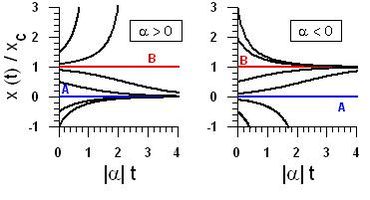Difference between revisions of "Template:This weeks featured article"
From Coastal Wiki
(Human activities and nature conservation conflicts at the Kenyan coastline) |
(Stability models) |
||
| Line 1: | Line 1: | ||
| − | == | + | ==Stability models== |
| − | [[ | + | [[image:stability1.jpg|thumb|370px|Fig.1: Left (<math>\alpha>0</math>), all the solutions starting in a neighborhood of the equilibrium A (<math>x=0</math>) tend to A for <math>t \to \infty</math> while there are solutions starting arbitrarily near B (<math>x=x_c</math>) that do not tend to B. Therefore, A is stable whereas B is unstable. Right (<math>\alpha<0</math>), now the contrary occurs, the A and B have exchanged their roles. ]] |
| − | + | Coastal systems may self-organize at various length and time scales. Sand banks, sand waves both in the shelf and at the coastline, sand bars, tidal inlets, [[cusp]]s, cuspate forelands, spits (among others) are morphological features that are frequently dominated by self-organized processes. Stability models are the genuine tool to understand these processes and make predictions on the dynamics of those features. | |
| − | + | The concepts of equilibrium and stability come from Classical Mechanics (see, for example, Arrowsmith and Place, 1992<ref>D. K. Arrowsmith and C. M. Place, 1992. "Dynamical Systems". Chapman and Hall/CRC.</ref>). A state where a system is in balance with the external forcing so that it does not change in time is called an '''equilibrium position'''. However, any equilibrium position may be either stable or unstable. If released near a '''stable''' equilibrium position, the system will evolve towards such a position. On the contrary, if released near an '''unstable''' equilibrium position, it will go far away from this position. | |
Revision as of 16:47, 20 October 2008
Stability models

Fig.1: Left ([math]\alpha\gt 0[/math]), all the solutions starting in a neighborhood of the equilibrium A ([math]x=0[/math]) tend to A for [math]t \to \infty[/math] while there are solutions starting arbitrarily near B ([math]x=x_c[/math]) that do not tend to B. Therefore, A is stable whereas B is unstable. Right ([math]\alpha\lt 0[/math]), now the contrary occurs, the A and B have exchanged their roles.
Coastal systems may self-organize at various length and time scales. Sand banks, sand waves both in the shelf and at the coastline, sand bars, tidal inlets, cusps, cuspate forelands, spits (among others) are morphological features that are frequently dominated by self-organized processes. Stability models are the genuine tool to understand these processes and make predictions on the dynamics of those features.
The concepts of equilibrium and stability come from Classical Mechanics (see, for example, Arrowsmith and Place, 1992[1]). A state where a system is in balance with the external forcing so that it does not change in time is called an equilibrium position. However, any equilibrium position may be either stable or unstable. If released near a stable equilibrium position, the system will evolve towards such a position. On the contrary, if released near an unstable equilibrium position, it will go far away from this position.- ↑ D. K. Arrowsmith and C. M. Place, 1992. "Dynamical Systems". Chapman and Hall/CRC.